Last Updated on November 22, 2024 by Kittredge Cherry
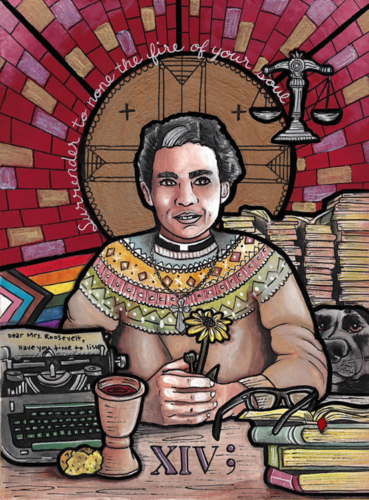
Human rights champion and queer saint Pauli Murray is a renowned civil rights pioneer, feminist, author, Episcopal priest and lawyer whose legal arguments were used in landmark Supreme Court decisions outlawing racism and sexism.
Murray was arrested and jailed for refusing to sit in the back of a segregated bus in Virginia in 1938 — 15 years before Rosa Parks became a national symbol for resisting bus segregation. This makes Murray the first African American to use non-violent action to challenge Jim-Crow segregation.
[Update: “To Speak a Defiant Word: Sermons and Speeches on Justice and Transformation” by Pauli Murray was published by Yale University Press in August 2023.]
Murray’s gender identity is under debate. The gender non-conformist is widely acclaimed as “the first black woman ordained as an Episcopal priest.” She was attracted to women and had the longest relationships with women, so is justifiably considered a lesbian. But Murray also sometimes identified as a man and sought masculinizing hormone treatments, so there are good reasons to consider him to be a transgender man.
Murray’s feast day is July 1. Her birthday happens to fall on Transgender Day of Remembrance, Nov. 20.
New in 2024: Icon shows Pauli Murray’s queer Christian complexity
Murray sits at a table with the bread and wine of communion beside a typewriter and a LGBTQ+ Pride flag backdrop in a new icon loaded with symbols. It appears at the top of this post. The icon was created by Kristen Wheeler, an iconographer, artist and writer based in New Orleans. Murray’s commitment to equality is illustrated by the scales of justice in perfect balance and the Roman numeral “XIV” for the Fourteenth Amendment granting U.S. citizenship to formerly enslaved people. Later it became the basis for legalizing same-sex marriage. In the typewriter is first letter she wrote to president Franklin Roosevelt, which led to friendship with his wife and First Lady, Eleanor Roosevelt.
Murray’s actual office was packed with books, just like this icon. As often happened in real life, a dog is at her side. A clergy collar peeks out from a unisex Nordic sweater, expressing Murray’s personality. A quote arches over Murray’s head like a halo: “Surrender to none the fire of your soul.” (from the poem “Ruth” in “Dark Testament and Other Poems.”) Wheeler offers “modern iconography with a folk-art twist” at ModernIconographer.com.
Pauli Murray is honored by church and government
This non-binary person was permanently added as an Episcopal saint in 2018 after being on the calendar of saints for “trial use” since 2009. Usually the Episcopalians wait until 50 years after a person has died before making granting sainthood, but the church made an exception and fast-tracked Murray on the road to sainthood. The honors are not only from churches, but also from government.
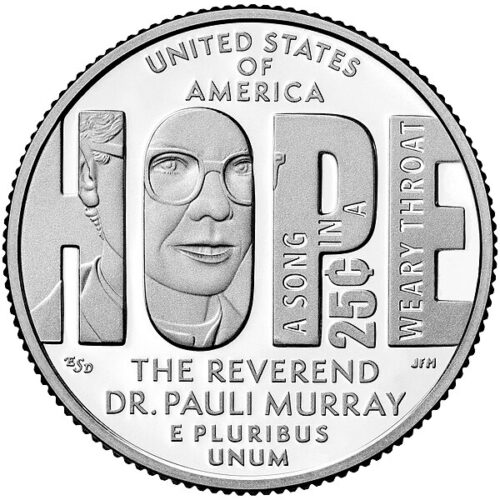
The Pauli Murray coin was released by the U.S. Mint in 2024.
Murray appeared on U.S. coins in 2024 as part of the American Women Quarters program. It depicts Murray looking out from the word “hope.” The inscription quotes a famous line from her poem “Dark Testament,” describing hope as “a song in a weary throat.” Her religious and academic credentials are highlighted by her title “Reverend Dr.” on the coin. Murray is the first and only priest to appear on U.S. money, blurring the boundary between church and state as Murray did during lifetime of legal and religious service.
The saint faced many obstacles in life, but often overcame them with the extraordinary attitude expressed in these quotes: “Don’t get mad, get smart” and “When my brothers try to draw a circle to exclude me, I shall draw a larger circle to include them.”
Pauli’s pronouns
This article follows the current standard among most historians and uses “she-her-hers” pronouns for Murray — the same pronouns that Murray used — while acknowledging that as new understandings evolve, a few scholars are starting to use “they/them/theirs” or “he-him-his” pronouns for Murray. Out of respect for multiple interpretations, this article reduces the use of pronouns in an attempt to let readers make their own decisions.
For more on the pronoun issue, see the articles “What about Pauli Murray and pronouns?” by the Pauli Murray Center and “Pauli Murray and the Pronominal Problem: a De-essentialist Trans Historiography” by Naomi Simmons-Thorne, and and the video “Gender Pronouns and The Life and Legacy of Pauli Murray” with Rosalind Rosenberg.
Pauli Murray struggled with gender since childhood
Others have written extensively about the saint’s many accomplishments, but material on Murray’s sexuality is harder to find. She did not speak publicly about sexual orientation or gender identity issues, but left ample evidence of these struggles in letters and personal writings.
Anna Pauline (Pauli) Murray (Nov. 20, 1910 – July 1, 1985) was born in Baltimore, Maryland into a middle-class family of mixed socio-economic and racial origins on both sides. Her mother was a nurse and her father was a teacher. She was sent to Durham, North Carolina, when at age three when her mother died, and raised by her maternal aunts and grandparents.
The child became aware of having a queer sexuality and/or identity early in life. In Pauli Murray and Caroline Ware: Forty Years of Letters in Black and White, historian Anne Firor Scott explains:
“In adolescence Murray began to worry about her sexual nature. She later said that she was probably meant to be a man, but had by accident turned up in a woman’s body. She began to keep clippings about various experiments with hormones as a way of changing sexual identity…. In 1937, at the initiative of a friend, she had been admitted to Bellevue Hospital in New York, and during her stay there she examined her worries about her sexual nature in writing, and said that she hoped to move toward her masculine side… . She continued for years to discuss the developing medical literature about hormones, thinking they might help her. She discussed the possibility of homosexuality with doctors; she knew that she was attracted to very feminine, often white, women, and she knew as well that… she was not physically attracted to men. This conflict would continue for the rest of her life.”
 One of the most comprehensive accounts of Murray’s inner life — including struggles against racism, homophobia, transphobia — comes in the 2020 biography “Pauli Murray: A Personal and Political Life” by Troy R. Saxby. He is an academic and research officer at the University of Newcastle. This intimate biography is published by University of North Carolina Press.
One of the most comprehensive accounts of Murray’s inner life — including struggles against racism, homophobia, transphobia — comes in the 2020 biography “Pauli Murray: A Personal and Political Life” by Troy R. Saxby. He is an academic and research officer at the University of Newcastle. This intimate biography is published by University of North Carolina Press.
 These issues are also explored in the definitive 2017 biography, “Jane Crow: The Life of Pauli Murray” by Columbia University history professor Rosalind Rosenberg. Murray coined the phrase “Jane Crow,” based on the term “Jim Crow,” to describe the double discrimination faced by black women. While serving on a presidential commission on women in the 1960s, she used the idea of “Jane Crow” to show similarities between racial and gender discrimination, decades before the concept of “intersectionality” became popular.
These issues are also explored in the definitive 2017 biography, “Jane Crow: The Life of Pauli Murray” by Columbia University history professor Rosalind Rosenberg. Murray coined the phrase “Jane Crow,” based on the term “Jim Crow,” to describe the double discrimination faced by black women. While serving on a presidential commission on women in the 1960s, she used the idea of “Jane Crow” to show similarities between racial and gender discrimination, decades before the concept of “intersectionality” became popular.
Rosenberg writes that Murray had an inner sense of being male since childhood, admitted to “homosexual tendencies” and tried unsuccessfully to convince doctors to administer testosterone in an effort to “treat” homosexuality by making Murray more male.
Murray also requested and was denied exploratory surgery to investigate the possibility of being intersex. When preparing papers to be archived, she deliberately included documents with Murray’s own personal reflections and experiences with multiple gender and sexual identities.
Murray’s queer side is discussed in many more books, including American Eugenics: Race, Queer Anatomy, and the Science of Nationalism by Nancy Ordover and To Believe in Women: What Lesbians Have Done For America
by Lillian Faderman, and in the play “To Buy the Sun: The Challenge of Pauli Murray” by Lynden Harris.
The saint’s best known book is Proud Shoes: The Story of an American Family (1956), a memoir of growing up as a mixed-race person in the segregated South. As a black family biography, it was a precursor to the blockbuster “Roots.”
 Murray also wrote an award-winning memoir titled “Song in a Weary Throat: Memoir of an American Pilgrimage,” which was published posthumously and reissued in 2018. That year brought the reissue of her book “Dark Testament and Other Poems,” which was first published in 1970 and long unavailable.
Murray also wrote an award-winning memoir titled “Song in a Weary Throat: Memoir of an American Pilgrimage,” which was published posthumously and reissued in 2018. That year brought the reissue of her book “Dark Testament and Other Poems,” which was first published in 1970 and long unavailable.
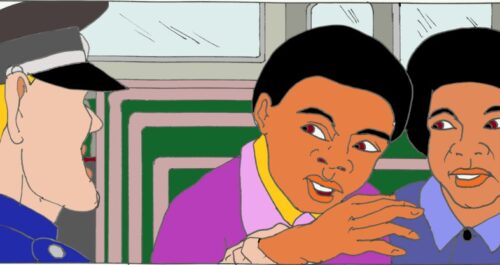
Artist Jan Haen shows the 1938 arrest of Pauli Murray and girlfriend Adelene McBean for defying segregation laws.
A little-known fact is that Murray was with dressed as a man at the time of the arrest, and was arrested along with girlfriend Adelene “Mac” McBean. In 1941 Murray organized restaurant sit-downs in the nation’s capital — 20 years before the famous Greensboro sit-ins.
Pauli Murray became an attorney and met “spiritual mate”
A graduate of New York’s Hunter College, Murray was rejected from the University of North Carolina UNC Chapel Hill’s graduate school in 1938 because of race. Eager to become a civil rights lawyer, Murray applied as a woman to Howard University in Washington, DC and became the only woman in the law school class there. Murray and gay saint Bayard Rustin both helped found the Congress of Racial Equality in 1942. In the 1940s both Murray and Rustin were associated with the influential Harlem Ashram, a community exploring how to use Gandhi’s nonviolent methods to end racial discrimination. Murray lived there briefly and Rustin visited frequently from his nearby home.
Despite graduating first in the class of 1944, Murray was rejected by Harvard because they didn’t accept women — even though President Franklin Roosevelt wrote a letter of support after Murray contacted First Lady Eleanor Roosevelt. Instead Murray studied law at the University of California in Berkeley, and began a friendship with Eleanor that lasted a quarter century. Murray wrote numerous influential publications, and NAACP used Murray’s ideas in the landmark 1954 Brown v. Board of Education case that ended racial segregation in U.S. public schools.
In the late 1950s, Murray began a loving relationship with “best friend” Irene (Renee) Barlow, the office manager at the law firm where Murray worked. Both were active Episcopalians when they met. They never lived together, but the interracial couple attended church together and maintained a relationship for almost 17 years until Barlow’s death from cancer in 1973. Murray described Barlow as a “spiritual mate.” She wrote a piece called “A Christian Friendship” for Barlow’s memorial booklet, declaring, “As one of the many friends blessed by Irene Barlow’s loving kindness, I was given both the high privilege—and the pain— of a Christian partnership of nearly seventeen years in which two independent spirits meshed when necessary and disengaged when it no longer crucial to act as a unit.”
 Murray’s ongoing friendship with Roosevelt is described in the 2016 book, “The Firebrand and the First Lady: Portrait of a Friendship: Pauli Murray, Eleanor Roosevelt, and the Struggle for Social Justice” by women’s studies professor Patricia Bell-Scott.
Murray’s ongoing friendship with Roosevelt is described in the 2016 book, “The Firebrand and the First Lady: Portrait of a Friendship: Pauli Murray, Eleanor Roosevelt, and the Struggle for Social Justice” by women’s studies professor Patricia Bell-Scott.
In the early 1960s President John Kennedy appointed Murray to the Commission on the Status of Women Committee. The future saint worked with Martin Luther King Jr. and openly gay activist Bayard Rustin on civil rights — and criticized the 1963 March on Washington at the time for excluding women from leadership. In 1965 Murray became the first African American to receive a law doctorate from Yale. A year later Murray co-founded the National Organization for Women. Before becoming a Supreme Court Justice, Ruth Bader Ginsberg relied on Murray’s legal arguments to win the Reed v. Reed case, a major milestone in prohibiting sex discrimination.
Pauli Murray had a second career as a priest
The death of beloved spiritual mate Irene Barlow led Murray to change careers from law to ministry. Instead of retiring, she launched a new career at age 62. The grieving lawyer entered New York’s General Theological Seminary in 1973, the same year that Barlow died — and before the Episcopal Church allowed women priests. Murray was ordained in 1977 and celebrated Holy Eucharist for the first time at the Chapel of the Cross in Chapel Hill, NC — the same church where Murray’s grandmother, an enslaved person, was baptized.
After a lifetime as a human rights activist, Murray drew on personal experience to preach a powerful vision of God’s justice. It can be difficult to locate her sermons in books. Eight of them can be found in the readily available book “Daughters of Thunder: Black Women Preachers and Their Sermons, 1850-1979,” edited by Bettye Collier-Thomas. Sermons by Murray in the book are Male and Female He Created Them (1978), Women Seeking Admission to Holy Orders as Crucifers Carrying the Cross (1974), Mary Has Chosen the Best Part (1977), The Holy Spirit (1977), The Gift of the Holy Spirit (1977), The Dilemma of the Minority Christian (1974), Salvation and Liberation (1979), and Can These Bones Live Again (1978).
A 1977 sermon recorded in the hard-to-find Pauli Murray: Selected Sermons and Writings includes these lines:
It was my destiny to be the descendant of slave owners as well as slaves, to be of mixed ancestry, to be biologically and psychologically integrated in a world where the separation of the races was upheld by the Supreme Court of the United States as the fundamental law of our Southland. My entire life’s quest has been for spiritual integration, and this quest has led me ultimately to Christ, in whom there is no East or West, no North or South, no Black or White, no Red or Yellow, no Jew or Gentile, no Islam or Buddhist, no Baptist, Methodist, Episcopalian, or Roman Catholic, no Male or Female. There is no Black Christ, no White Christ, no Red Christ – although these images may have transitory cultural value. There is only Christ, the Spirit of Love.
Murray died of pancreatic cancer on July 1, 1985 at age 74 in a house co-owned with lifelong friend Maida Springer Kemp in Pittsburgh, Pennsylvania. Murray and spiritual mate Irene Barlow are said to be buried together under the same headstone in an interracial cemetery in Brooklyn, New York.
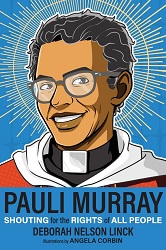 Since then Murray has received many honors, such as becoming the namesake for a residential college at Yale University in New Haven, Connecticut. Pauli Murray College opened to students in the 2017 academic year.
Since then Murray has received many honors, such as becoming the namesake for a residential college at Yale University in New Haven, Connecticut. Pauli Murray College opened to students in the 2017 academic year.
What is probably the first children’s book about Murray was released in 2022 by Morehouse Publishing, an imprint of Church Publishing, the official publisher of worship resources for the Episcopal Church. “Pauli Murray: Shouting for the Rights of All People” by Deborah Nelson Linck (author) and Angela Corbin (illustrator) is aimed at readers ages six to 12.
What color is Pauli Murray’s halo?
Multiple interpretations of Murray are expressed in two recent portraits: Murray gets a rainbow halo from North Carolina iconographer Jeremy Whitner and a transgender halo from Dutch artist Jan Haen. Both works were created in 2022.

Pauli Murray icons by Jeremy Whitner (left) and Jan Haen.
Whitner is a queer Christian iconographer in process for ministry with the Disciples of Christ. He attends Union Presbyterian Seminary in Charlotte, North Carolina. His icons appear frequently on Q Spirit and are available at Whitner’s Fine Art America shop.
Whitner returned to portray Murray again in 2023 right after the U.S. Supreme Court ruled to limit LGBTQ rights in Creative LLC v. Elenis. This time Murray appears in priestly majesty in a church setting… giving us a blessing or offering prayers on our behalf. Her rainbow halo shines brightly against the deep purple roles and backdrop.
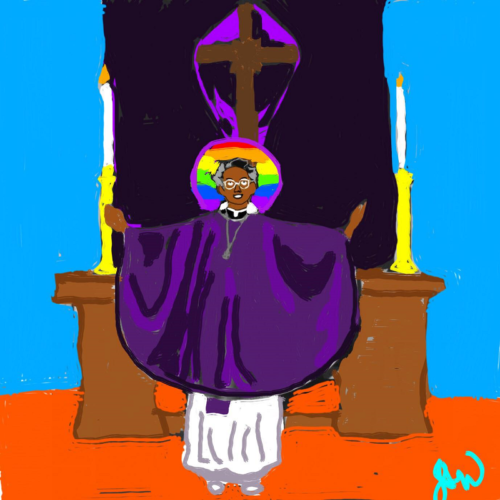
“Rev. Pauli Murray: Law and Wisdom” by Jeremy Whitner, 2023
Murray’s life story is told in the 2023 book “Heavenly LGBTQ+: Queer Icons from LGBTQ Life, Religion, and History” by Dutch artist and Redemptorist priest Jan Haen. He includes scenes that are rarely if ever portrayed by artists, such as Murray being arrested. It is the sequel to his 2022 graphic non-fiction book “Heavenly Homos, Etc..” Saints and heroes of the LGBTQ community come alive through bold artwork in these illustrated book. Saints and historical figures from all over the world are presented. Short, accessible text lets the pictures tell their stories. Its deceptively simple style conveys sophisticated understandings of sexual orientation and queer Biblical scholarship.
Pauli Murray in art and films
Murray understood the value of art with words such as, “Great art is not a matter of presenting one side or another, but presenting a picture so full of the contradictions, tragedies, [and] insights of the period that the impact is at once disturbing and satisfying.” This quote is the epigraph at the beginning of the book “The Passion of Christ: A Gay Vision” by Kittredge Cherry with art by Doug Blanchard.
Murray is pictured as a priest in the act of celebrating communion, with broken bread in hand and a chalice of wine, in a 2022 icon by by Kelly Latimore. Murray’s purple robe suggests the blending of male and female genders. Latimore is known for painting innovative icons of unlikely contemporary saints such as Stonewall saint and trans activist Marsha P. Johnson and the migrant family in his best-known work “Refugees: La Sagrada Familia.” He began painting icons in 2011 while he was a member of the Common Friars, an emerging Episcopal monastic community in Athens, Ohio.
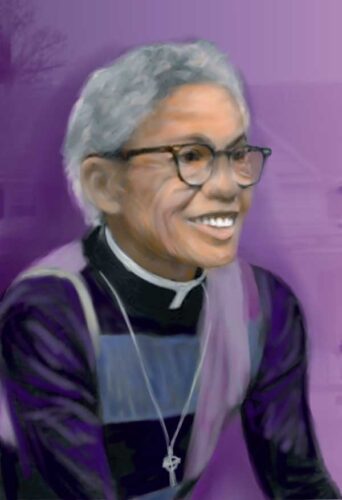
Pauli Murray by Laurel Green
North Carolina artist Laurel Green creates digital artworks in conversation with more traditional media, including an image of Pauli Murray against a purple background as part of the “In the Spirit of Those Who Led the Way” series.
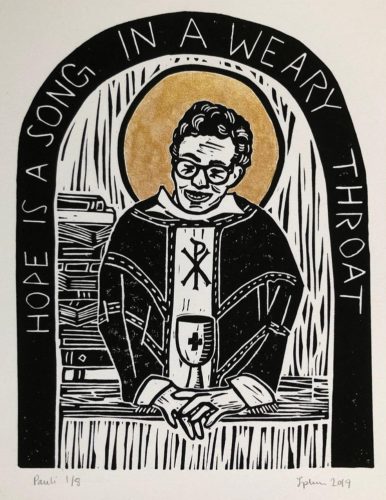
“Pauli Murray Icon” by L. Plum.
Pauli Murray appears with a golden halo in a hand-carved linocut print icon by L. Plum of Nashville. Murray stands in clerical robes at the communion table with the chalice that is used to share Christ’s life and love with the community during the Holy Eucharist sacrament. Arching overhead is a line from one of Murray’s most memorable poems: “Hope is a song in a weary throat.” A tall stack of books is piled up behind, hinting at other careers as a writer and attorney.
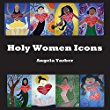 An icon of Pauli Murray was painted for the “Holy Women Icons” series by Angela Yarber, founder and creative director of the Tehom Center, formerly known as the Holy Women Icons Project. She is a painter, author, scholar, dancer, minister and LGBTQ-rights activist based in Hawaii and North Carolina. She earned a Ph.D. in art and religion from the Graduate Theological Union at the University of California in Berkeley. Nearly 50 color images of her folk feminist icons included in her book “Holy Women Icons.” Her colorful icon shows Murray with a closed eyes and large heart inscribed with the words:
An icon of Pauli Murray was painted for the “Holy Women Icons” series by Angela Yarber, founder and creative director of the Tehom Center, formerly known as the Holy Women Icons Project. She is a painter, author, scholar, dancer, minister and LGBTQ-rights activist based in Hawaii and North Carolina. She earned a Ph.D. in art and religion from the Graduate Theological Union at the University of California in Berkeley. Nearly 50 color images of her folk feminist icons included in her book “Holy Women Icons.” Her colorful icon shows Murray with a closed eyes and large heart inscribed with the words:
“When her throat grew weary,
Her heart pulsed a song of hope,
Of justice, of equality,
Unconstrained by the binaries
That bind.
Authentically free.”
For more info on Yarber, see my previous post “Artist paints holy lesbians and other women.”
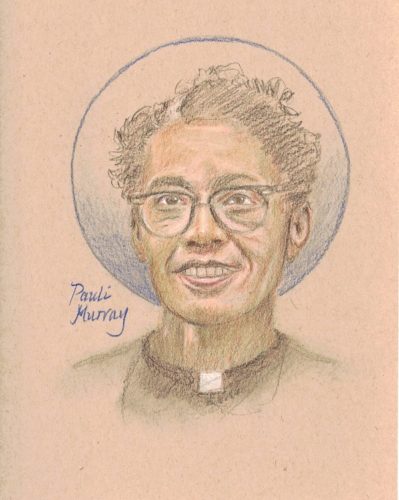
“Pauli Murray” by Tobias Haller, 2021
An icon of Murray was sketched by Tobias Haller in 2021. Haller, a retired Episcopal vicar who still assists at a parish in Baltimore, enjoys creating icons of LGBTQ people and other progressive holy figures as well as traditional saints.

“Tiny icon: Pauli Murray” by Miranda of the Nifflenoggin shop on Etsy.
Pauli Murray shows a non-binary nature in a tiny icon based loosely on a photo taken as a self-portrait. It was crafted by Miranda of the Nifflenoggin shop on Etsy. Murray’s head is enamel on copper, mounted on a golden wood halo.
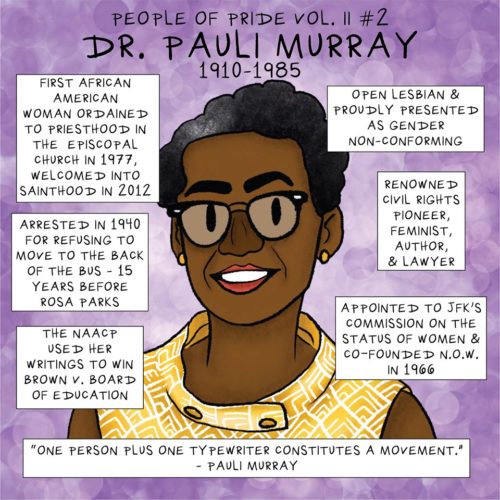
“Dr. Pauli Murray: People of Pride Vol. II #2” by Elijah Haswell
Murray is also included in the “People of Pride” project by Elijah Haswell, a queer transgender artist dedicated to accessible, inclusive non-fiction. The series celebrates historic LGBTQ+ Americans with cartoon-like portraits, boxes packed with fun factoids, and a quick quotation. The quote chosen for Murray is: “One person plus one typewriter constitutes a movement.” Haswell began the series in 2018 and it was so popular that a “People of Pride” book was released with redrawn illustrations and its own Kickstarter campaign.
In 2021 the documentary film “My Name is Pauli Murray” premiered at the Sundance Film Festival and started streaming on Amazon. It was directed by Betsy West and Julie Cohen, the Oscar-nominated film-making team behind the movie “RBG.”
Pauli Murray prayers
Q Spirit’s Litany of Queer Saints includes this line:
Saint Pauli Murray, we join you in asking for a song of hope in a weary throat, and a world where we can sing it. Pray for us!
The trial use commemorations of the Episcopal Church include this new prayer:
Liberating God, we thank you most heartily for the steadfast courage of your servant Pauli Murray, who fought long and well: Unshackle us from bonds of prejudice and fear so that we show forth your reconciling love and true freedom, which you revealed through your Son and Our Savior Jesus Christ.
Links related to Pauli Murray
Center honoring trailblazing lawyer, civil rights activist and priest opens in Durham (ReligionNews.com, Sept. 6, 2024)
“Christian, Queer and Interracial: the story of Pauli Murray and Irene Barlow” by Hiroki Kimiko Keaveney (San Francisco State University thesis)
Pauli Murray inspires new generation of ‘firebrand’ Black, queer Episcopal leaders (Episcopal News Service, Dec. 9, 2020)
Pauli Murray Named to Episcopal Sainthood (duke.edu)
Pauli Murray bio (Episcopal Diocese of North Carolina)
“Queering Iconography, Painting Pauli Murray” by Angela Yarber (Feminism and Religion Blog)
___
To read this article in Italian, go to:
Pauli Murray, una cristiana queer in lotta contro le catene del pregiudizio (Gionata.org)
___
Top image credit:
Pauli Murray icon by Kristen Wheeler of ModernIconographer.com
___
This post is part of the LGBTQ Saints series by Kittredge Cherry. Traditional and alternative saints, people in the Bible, LGBTQ martyrs, authors, theologians, religious leaders, artists, deities and other figures of special interest to lesbian, gay, bisexual and transgender and queer (LGBTQ) people and our allies are covered.
This article was originally published in June 2017, expanded with new material over time, and most recently updated on Nov. 22, 2024.
Copyright © Kittredge Cherry. All rights reserved.
Qspirit.net presents the Jesus in Love Blog on LGBTQ spirituality.






















Trackbacks/Pingbacks